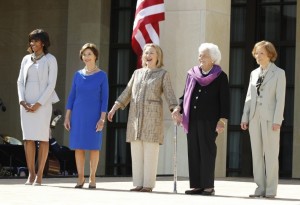
First lady Michelle Obama poses with former first ladies Laura Bush, Hillary Clinton, Barbara Bush and Rosalynn Carter as they attend the dedication ceremony for the George W. Bush Presidential Center in Dallas, April 25, 2013. (Jason Reed/Reuters)
He’s unmarried. An avowed bachelor. If he won the White House, he’d have no spouse at his side.
But Sen. Lindsey Graham (R-S.C.) had a suggestion this week. It includes his sister. And maybe some female friends.
“We’ll have a rotating first lady,” he said in a wide-ranging interview with London’s Daily Mail.
But why does an unmarried president even need one (or in Graham’s case, several)? Does the country still require a stand-in hostess at social events? Or a singular person to use the national platform to adopt a cause widely considered serious, but not serious enough for the president to undertake?
These are questions we haven’t faced in more than 100 years. For as long as anyone reading this has been alive, the president has had a wife and that wife was the first lady.
The last bachelor elected to the White House was Grover Cleveland in 1886, but he married in his first term. James Buchanan, elected in 1857, was the only unmarried president to stay single his whole life.
Buchanan never had a wife, but he still had a first lady. The job went to his niece, Harriet Lane Johnston, who assumed the role of White House hostess and used her proximity to power to champion several social causes.
In the outside chance that Graham were to win the presidency (he’s polling around 1 percent), he’d likely be expected to have a first lady to, at a minimum, fill the social responsibilities around state dinners and holiday events and other such residence affairs.
In the 21st century, having a ceremonial hostess might not be as much of a necessity, certainly not just to have “someone in a pretty dress to be available to shake hands,” Katherine Jellison, expert in First Ladies Studies at Ohio University, said.
But even as the role has evolved and modernized, the social side of government remains an integral part — even for those first ladies (Hillary Clinton being the obvious example) who preferred their personal policy initiatives over picking floral arrangements.
But to diminish the role to merely its more aesthetic side is to miss its greater value. This person, whether a wife or a relative or a friend, “is the closest person in the White House to the president … designated to be a voice, an advocate, a surrogate…,” said Anita McBride, the former chief of staff for Laura Bush from 2005 to 2009, now with American University. “The position is one that is constantly evolving …one common thread is that whoever is doing the job is there to support the Commander in Chief.”
Now the Brits seem quite infatuated with this question of the untraditional first lady. Before posing the question to Graham, the Daily Mail wrote an article in May centered on an assertion from C-Span President Susan Swain that a Hillary Clinton administration may see Chelsea Clinton as the first lady.
“There is a social function to the first lady’s role, and that will not go away,” Swain, who wrote a book on first ladies, told the British tabloid. Chelsea Clinton was the logical person to fill the slot, she reasoned.
It’s not because a first gentleman couldn’t pick centerpieces or Easter egg designs. Or take on a social cause. But it might be a bit strange if Hillary Clinton’s husband managed the East Wing after running the West Wing.
But whatever form a first lady takes in the future — a wife, a husband, a sister, a good friend — the office itself is here to stay.
Story by


